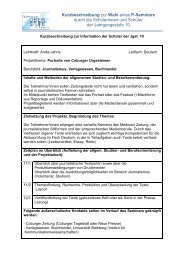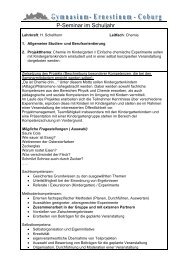Style Sheet: MLA (Modern Language Association) Style Citations
Style Sheet: MLA (Modern Language Association) Style Citations
Style Sheet: MLA (Modern Language Association) Style Citations
Create successful ePaper yourself
Turn your PDF publications into a flip-book with our unique Google optimized e-Paper software.
2<br />
If the work you are making reference to has no author, use an abbreviated version of the<br />
work’s title. For non-print sources, such as films, TV series, pictures, or other media, or<br />
electronic sources, include the name that begins the entry in the Works Cited page. For<br />
example:<br />
The UC Berkeley Campus Code of Student Conduct defines plagiarism as “the use of<br />
intellectual material produced by another person without acknowledging its source” (<strong>Style</strong><br />
<strong>Sheet</strong>s for Citing Resources).<br />
Sometimes you may have to use indirect quotation. An indirect quotation is a quotation that<br />
you found in another source that was quoting from the original. For such indirect quotations,<br />
use “qtd. in” to indicate the source. For example:<br />
Miller himself said that “the story of Salesman is absurdly simple! It is about a salesman<br />
and it’s his last day on the earth” (qtd. in Bigsby 104).<br />
For works with more than two authors or editors use first author’s name and “et al.” (Latin: et<br />
alii = and others).<br />
Quotations<br />
To indicate short quotations (fewer than four typed lines of prose or three lines of verse) in<br />
your text, enclose the quotation within double quotation marks and incorporate it into your<br />
text. Punctuation marks such as periods, commas, and semicolons should appear after the<br />
parenthetical citation. Questions marks and exclamations marks should appear within the<br />
quotation marks if they are a part of the quoted passage (then you still need a period after the<br />
parenthetical citation!) but after the parenthetical citation if they are a part of your text.<br />
“Incorporating” short quotations into your text means that you must be careful that the<br />
grammatical forms and the sentence structure are correct. Therefore, it is sometimes necessary<br />
to add or omit words or even change forms. All these changes must be indicated by using<br />
brackets and ellipsis marks. For example:<br />
Harold Bloom argues that “His [i. e. Graham Greene’s] more celebrated novels fade already<br />
into the continuum of literary tradition” (8).<br />
-> The additional information is given in square brackets.<br />
-> A capital letter (His) is used with the first word of a direct quotation of a whole sentence.<br />
-> Do not use a capital letter with the first word of a direct quotation of part of a sentence.<br />
According to Lawrence we are all relieved that not everybody is as deluded as Willy “When<br />
Biff says […] that his father ‘had the wrong dreams’” (57).<br />
-> If you omit a word or words from a quotation you must indicate the deleted word(s) by<br />
using ellipsis marks surrounded by square brackets.<br />
-> For a quotation within a quotation you should use single quotation marks.<br />
When Joachim tells Hans Castorp that Behrens is annoyed by patients who aren’t willing to<br />
die, Hans Castorp says, “Daß [sic] geht nicht, daß man ihn so mir nichts, dir nichts –”, but<br />
he can’t finish the sentence because he bursts out laughing (Mann 80).<br />
-> Use [sic] (Latin = “so”, “thus”) to indicate that a mistake is in the source you are quoting<br />
and not your own.

















